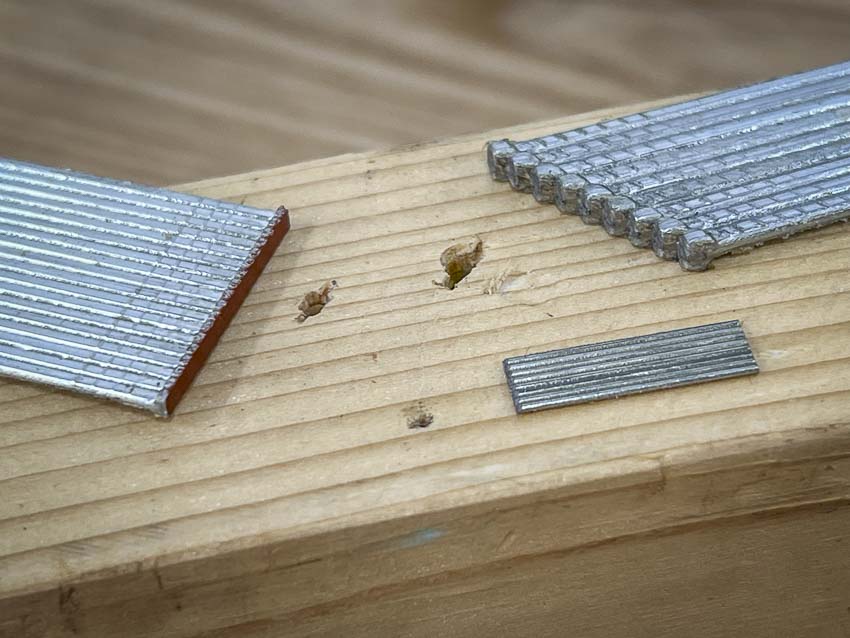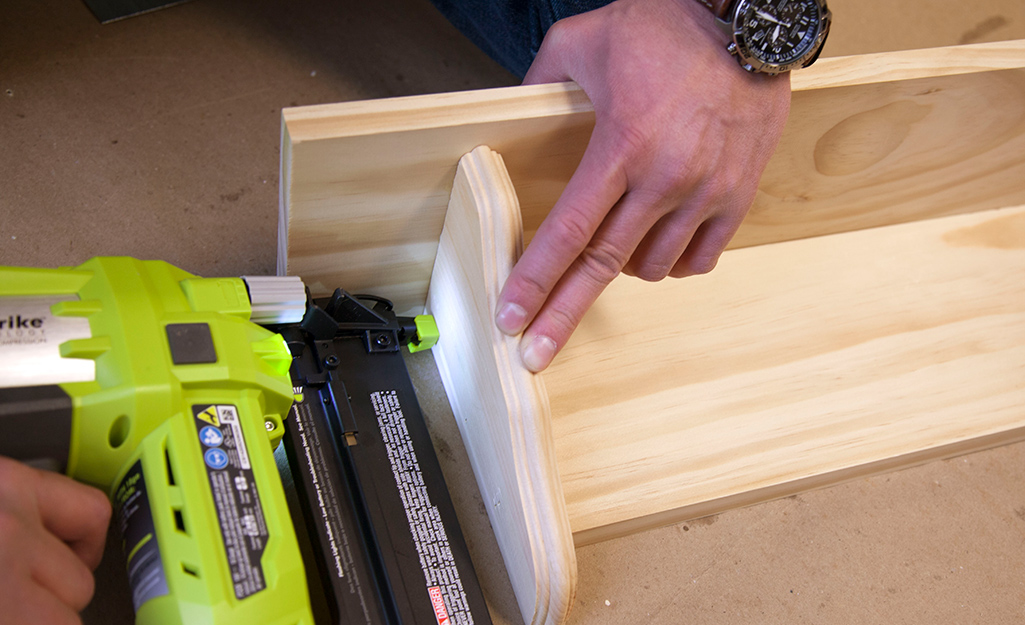A 15-gauge finish nailer is ideal for trim projects. It provides the right balance of size and strength for securing trim without causing damage.
When choosing a finish nailer for trim, it’s important to consider the thickness of the trim material and the size of the nails you plan to use. A 15-gauge finish nailer is versatile enough to handle most trim sizes and will provide a reliable and professional result.
Whether you’re installing baseboards, crown molding, or window casings, a 15-gauge finish nailer is the go-to tool for trim projects. With its ability to leave clean and secure finish nails, it’s the perfect choice for achieving a polished and professional look.
Understanding The Importance Of Choosing The Right Size Finish Nailer
Choosing the right size finish nailer is crucial for trim projects. The size of the nailer directly impacts the quality and durability of the finished trim. Using the wrong size can cause various issues like splitting, cracking, and even weakening the trim. It’s important to consider certain factors when deciding on the appropriate size. These factors include the thickness of the trim material, the type of trim being used, and the desired holding power required for the project. By selecting the correct size finish nailer, you can ensure a secure and elegant finish for your trim. So, make sure to analyze the requirements of your project before choosing the size of your finish nailer.
Different Sizes Of Finish Nailers And Their Applications
Finish nailers come in various sizes to accommodate different trim projects. Understanding the range of sizes and their applications is essential for achieving professional results.
Exploring the range of finish nailer sizes available in the market:
| Nailer Size | Applications |
|---|---|
| 15 Gauge | Ideal for baseboards, crown molding, and heavy trim |
| 16 Gauge | Suitable for general trim work and narrow crown moldings |
| 18 Gauge | Great for light trim, paneling, and delicate moldings |
| 23 Gauge | Perfect for delicate moldings, veneer, and other light applications |
Pros and cons of using different sizes for various trim projects:
- 15 Gauge: Provides excellent holding power, but may leave larger holes to fill.
- 16 Gauge: Versatile option suitable for most trim projects.
- 18 Gauge: Leaves smaller holes that are easier to fill, but may lack holding power in heavier applications.
- 23 Gauge: Provides the least holding power, but leaves virtually invisible holes that require minimal filling.
Matching nail lengths to the thickness and material of the trim: It is essential to choose the appropriate nail length to ensure a secure and flush installation. For thicker and denser materials, longer nails are typically required. Additionally, considering the angle of the nailer and the desired depth of penetration is important for achieving optimal results without damaging the trim.
Choosing The Right Size Finish Nailer For Different Trim Materials
When choosing the right size finish nailer for different trim materials, it’s important to consider the optimal nail size for wood trim applications. For wood trim, a 15 or 16-gauge finish nailer is typically recommended, as it provides enough strength and durability. The ideal nail length for MDF and composite trim materials may vary, so it’s best to consult the manufacturer’s guidelines or test a few different lengths to find the most suitable option. Additionally, when working with different types of upholstery trim, it’s important to consider the thickness and material of the trim. Using a narrow crown stapler can often be the best choice, as it provides secure fastening without damaging the trim. Overall, selecting the right size finish nailer for trim is essential to ensure a professional and long-lasting finish in your project.

Credit: www.protoolreviews.com
Factors To Consider When Selecting The Proper Size Finish Nailer
Factors to consider when selecting the proper size finish nailer include power and durability requirements for specific trim projects, compatibility with the air compressor or power source, and user-friendliness and maneuverability based on the size of the nailer.
When choosing a finish nailer, it is important to take into account the power and durability needed for the specific trim projects you will be working on. Whether you are installing baseboards, crown molding, or window casings, you want a nailer that has enough power to securely fasten the trim without causing any damage.
Another factor to consider is the compatibility of the nailer with your air compressor or power source. Make sure the nailer you choose is appropriate for your setup and can be easily connected to your air compressor or power tool.
Lastly, consider the size of the nailer in relation to your own user-friendliness and maneuverability preferences. Some people may find larger nailers more cumbersome to work with, while others may prefer the extra power and stability they provide. Choose a size that you are comfortable working with for extended periods of time.
Understanding Gauge And Angle Types For Finish Nailers
Understanding Gauge and Angle Types for Finish Nailers
Gauge is a crucial factor to consider when selecting a finish nailer for trim applications. The gauge determines the size or thickness of the nails used. The most common gauges for finish nailers are 15, 16, and 18. A lower gauge number means a thicker nail.
| Angle Type | Pros | Cons |
|---|---|---|
| 15° | Allows for tighter, more precise placement in tight corners | Requires a specific type of nail gun, which may limit options |
| 16° | Wider range of nail guns available | Slightly larger nail heads may be visible |
| 18° | Compatible with most nail guns | Not as versatile in tight spaces |
When choosing a finish nailer for trim applications, it’s important to consider factors such as the thickness and material of the trim, as well as the desired finish. For delicate trims, a higher gauge with a smaller nail head may be preferred to minimize damage. The angle type should be selected based on the specific requirements of the project, considering factors like tight corners and accessibility. Ultimately, finding the perfect combination of gauge and angle can result in seamless and professional-looking trim installations.
Tips For Ensuring Quality And Efficiency With The Chosen Finish Nailer Size
Proper handling and safety measures are crucial when using finish nailers. Carefully read the manufacturer’s instructions and always wear appropriate safety gear, such as safety glasses and ear protection, when operating a finish nailer. Position the tool firmly against the work surface before pulling the trigger to ensure accuracy and avoid accidental firing. To prevent nail splitting and damage to trim materials, choose the correct nail size for your project. Generally, 15- or 16-gauge finish nails are recommended for trim work. When selecting the nailer size, consider the thickness of the trim and the type of material you’re working with. For a professional-grade finish, make sure the nail heads are flush with the surface and conceal them with wood putty or trim caulk. Take your time and practice proper technique to achieve clean and secure results with your chosen finish nailer size.
Common Mistakes To Avoid When Selecting The Size Of Finish Nailer
Common Mistakes to Avoid when Selecting the Size of Finish Nailer
Overlooking the importance of nail length for different trims: One common mistake to avoid is overlooking the importance of nail length when selecting a finish nailer for different trims. Different trims require different sizes of nails to ensure a secure and professional finish. Using nails that are too long or too short can result in a compromised installation and an unappealing look.
Choosing an inadequate size based solely on budget considerations: Another mistake to avoid is choosing an inadequate size finish nailer based solely on budget considerations. While it may be tempting to opt for a smaller nailer to save money, it can lead to difficulties in driving nails into harder materials or larger trim pieces. Investing in the appropriate size for your specific project will ultimately save you time and ensure a successful result.
Misjudging the requirements of specific trim projects and materials: Lastly, misjudging the requirements of specific trim projects and materials can also lead to errors in nailer size selection. Each project and material may have unique characteristics and recommendations for nail size. It is essential to thoroughly assess the project requirements and consult with professionals or refer to manufacturer guidelines to make an informed decision.
Frequently Asked Questions For What Size Finish Nailer For Trim
What Gauge Finish Nailer Is Best For Trim?
The best gauge finish nailer for trim is usually a 15 or 16 gauge. These gauges provide enough holding power for trim materials without causing splitting or damage.
Should I Use 16 Or 18 Gauge Nails For Trim?
Use 16 gauge nails for trim. They provide adequate strength and hold without splitting the wood. 18 gauge nails may not be sturdy enough and can cause damage.
Can You Use 18 Gauge Brad Nailer For Trim?
Yes, you can use an 18 gauge brad nailer for trim.
Can You Use 18 Gauge Nails For Baseboards?
Yes, you can use 18 gauge nails for baseboards. They are strong enough to securely hold the baseboards in place. However, it is important to ensure that the length of the nail is suitable for the thickness of the baseboard material to avoid any splitting or damage.
Conclusion
To sum up, choosing the right size finish nailer for trim is crucial for achieving professional and flawless results. The size of the trim and the type of material will be the deciding factors in selecting the appropriate nailer. From 15-gauge to 18-gauge nailers, make sure to consider the thickness and width of the trim, as well as the intended application, to determine which size is best suited for your project.
By investing in the right tool, you can ensure that your trim work is not only aesthetically pleasing but also durable and long-lasting.





Leave a Reply